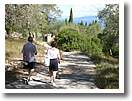
Paxos Places Of Interest
As much of Paxos is given over to olive production and with the island being so small, there is relatively little to see and do except drink in the charm and tranquility of the island.
There are, however, a few sights that are worth seeing during your trip to Paxos. Conveniently, most of the tourist attractions are based in or near the three main villages of Gaios, Lakka and Loggos.
Paxos Churches
Considering the tiny size of Paxos, the island has an impressive sixty or so churches scattered through the island. Several of these are near the villages, though many are only to be found by exploring the miles of pathways that eminate from the villages and crisscross the island. The most unique place of worship on Paxos is the quaint monastery on the island of Panayia in Gaios harbour. You will need a permit to visit this, however, which can be obtained from the local authority in the village (telephone: +30 26620 32100). There are two further churches on the neighbouring island of St Nicholas (permission also required).

Most of the popular tourist attractions are either in the three main villages or can be reached on foot via the pathways that wind their way through the olive grove interior of Paxos.
For more photos and videos of Paxos, see the Gallery page.
Paxos Folk Museum
The south side of the harbour in Gaios has two points of interest: On the harbourside there is a statue in honour of a young Paxos man who unsuccessfully attempted to raise a rebellion against the Ottoman Empire. Also at the southern side of the harbour is the Paxos Folk Museum. Here you can take a glimpse into the history of life on Paxos. The museum is located in a building that dates from 1906 and was formerly the village junior school. Artifacts in the museum include: olive press and olive production implements; fossils; pottery from various periods through history; guns, tools and other utensils from the Venetian and British empire periods. There are several rooms laid out to demonstrate living conditions and standards of the relavent periods. There is a small charge to enter the museum which is open for an hour every evening through the main holiday season (May to October).
Olive Press Museum
Between Loggos and Lakka, near the village of Magazia, there is an olive press museum. Built in 1865, the press was in use until 1960. Having only been restored in recent years, the olive press museum makes for an interesting excursion. Opening hours are: 11.00 - 14.00 and it is possible to buy some of the local produce here.
There is an impressive lighthouse in Lakka safeguarding boats from the rocky northern coastline of Paxos. From the northern tip of the island you can explore the west coast of Paxos by following one of the pathways round the headland from Lakka.
The rugged west coast that leads to the south of the island via the spectacular West Coast Cliffs, begins at Lakka. Following the peaceful coastal path from Lakka you can enjoy memorable views of the shoreline and find secluded coves and rocky beaches to enjoy. The sunsets that can be viewed from the coastal path are often a sight to behold.
To the north of Loggos, overlooking the harbour is the ruin of an old windmill. You can reach this from one of the many pathways from the vilage. The views from the windmill make the steep trek up from the village worthwhile as you can see most of the east coast of Paxos from here as well as the southern tip of Corfu and the west coast of mainland Greece.
On the north-west side of Loggos harbour stands the ruin of a stone built soap factory. The entrance to the factory boasts an impressive Romanesque statue that looks down from it's perch over the main square of the village.
Fontana
Also known as Platinos, Fontana lies in the heart of the northern Paxos. Much quieter than Gaios, Lakka and Loggs, which are busy with touists during the summer months, Fontana seems to be stuck in a time warp. There is only one taverna here that is a central meeting point for the locals to discuss their daily lives working the olive crops. Fontana is approximately a thirty minute walk from the coast and is worth a visit to see what much of Greece must have been like a hundred years ago.